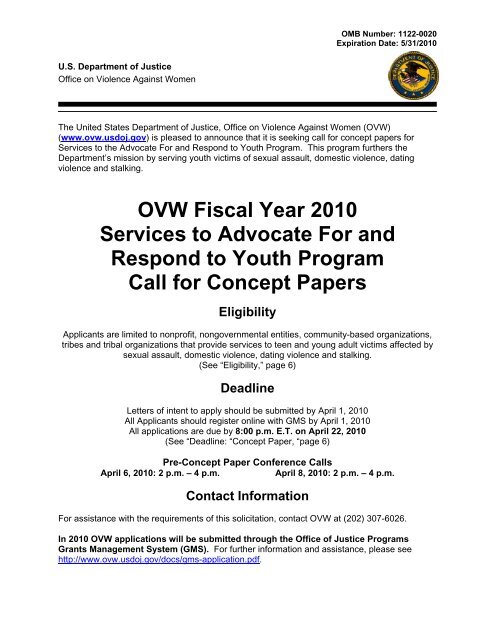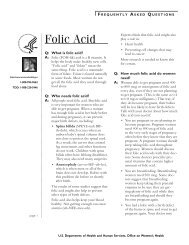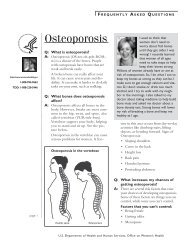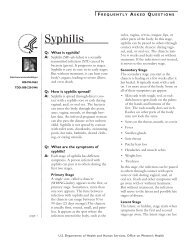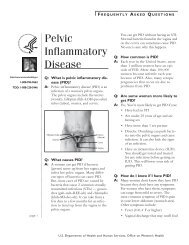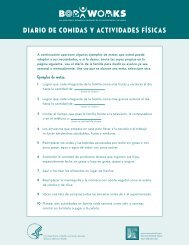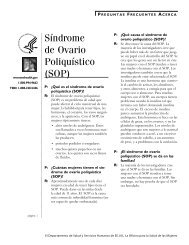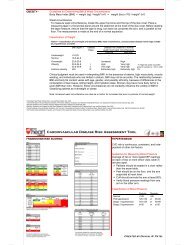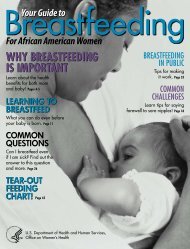OVW Fiscal Year 2010 Services to Advocate For and Respond to ...
OVW Fiscal Year 2010 Services to Advocate For and Respond to ...
OVW Fiscal Year 2010 Services to Advocate For and Respond to ...
Create successful ePaper yourself
Turn your PDF publications into a flip-book with our unique Google optimized e-Paper software.
OMB Number: 1122-0020Expiration Date: 5/31/<strong>2010</strong><strong>OVW</strong> <strong>Services</strong> <strong>to</strong> <strong>Advocate</strong> <strong>For</strong> <strong>and</strong> <strong>Respond</strong> <strong>to</strong> Youth Program(CFDA # 16.018 ) OverviewThis solicitation contains information on how <strong>to</strong> apply for the <strong>Services</strong> <strong>to</strong> <strong>Advocate</strong> <strong>and</strong> <strong>Respond</strong><strong>to</strong> Youth 1 Program (Youth <strong>Services</strong> Program). <strong>For</strong> general information on applying for all <strong>OVW</strong>grant programs, please see the <strong>OVW</strong> <strong>Fiscal</strong> <strong>Year</strong> <strong>2010</strong> Grant Program Solicitation ReferenceGuide (Reference Guide) at http://www.ovw.usdoj.gov/docs/resource-guidebook.pdf. Allapplicants should read carefully both this solicitation <strong>and</strong> the Reference Guide before beginningthe application process.About the <strong>OVW</strong> <strong>Services</strong> <strong>to</strong> <strong>Advocate</strong> <strong>For</strong> <strong>and</strong> <strong>Respond</strong> <strong>to</strong> Youth ProgramNationally, approximately one in three teen girls in the United States is a victim of physical,emotional or verbal abuse from a dating partner. This figure far exceeds victimization rates forother types of violence affecting youth. 2 Congress <strong>and</strong> victim advocates recognized the need <strong>to</strong>develop the nation’s capacity <strong>to</strong> provide direct intervention <strong>and</strong> related assistance services foryouth victims. In response, Congress created the Youth <strong>Services</strong> Program as part of theViolence Against Women <strong>and</strong> Department of Justice Reauthorization Act of 2005 (VAWA 2005),42 U.S.C. §14043. This is the first Federal funding stream solely dedicated <strong>to</strong> the provision ofdirect intervention <strong>and</strong> related assistance for youth victims of sexual assault, domestic violence,dating violence <strong>and</strong> stalking. Overall, the purpose of the Youth <strong>Services</strong> Program is <strong>to</strong> providedirect counseling, advocacy, legal advocacy, <strong>and</strong> mental health services for youth victims ofsexual assault, domestic violence, dating violence, <strong>and</strong> stalking, as well as linguistically,culturally, or community relevant services for underserved populations.Youth victims of sexual assault, domestic violence, dating violence <strong>and</strong> stalking requirespecialized services designed <strong>to</strong> meet the specific needs of youth <strong>and</strong> young adults. Whilethese crimes affect women regardless of their age; youth are especially vulnerable <strong>and</strong> faceunique obstacles if they decide <strong>to</strong> seek help. Unlike many adults, youth may not have access <strong>to</strong>money, transportation, child-care or <strong>to</strong> safe shelter. Additionally, youth <strong>and</strong> young adults maybe inexperienced with dating <strong>and</strong> may mistake potential abusive behavior such as jealousy as asign of love.Furthermore, in working with youth <strong>and</strong> young adults, there are concerns regarding lack ofconfidentiality <strong>and</strong> when or if <strong>to</strong> involve child protective services in cases of assault. Procedures<strong>and</strong> policies are necessary <strong>to</strong> develop <strong>and</strong> enhance m<strong>and</strong>a<strong>to</strong>ry reporting laws in each State <strong>and</strong><strong>to</strong> address the need for parental notification <strong>and</strong> consent guidelines.Youth victimized by other youth often face additional challenges in a “closed” schoolenvironment. <strong>For</strong> example, youth victims of sexual assault, domestic violence, dating violence<strong>and</strong> stalking may continue <strong>to</strong> live in danger if the perpetra<strong>to</strong>r resides in the same community,1 Youth refers <strong>to</strong> teens <strong>and</strong> young adults between the ages of 13-24.2 Davis, An<strong>to</strong>inette, MPH. 2008. Interpersonal <strong>and</strong> Physical Dating Violence among Teens. The National Councilon Crime <strong>and</strong> Delinquency Focus. Available at http://www.nccdcrc.org/nccd/pubs/Dating%20Violence%20Among%20Teens.pdf3
OMB Number: 1122-0020Expiration Date: 5/31/<strong>2010</strong>shares mutual friends, or attends the same classes. In smaller schools or communities, a victimmay wish <strong>to</strong> remain anonymous but may find this virtually impossible in an insular environment.Similarly, stalking victims may find it difficult <strong>to</strong> escape their <strong>to</strong>rmenters, because the stalkermay have a “legitimate” reason for remaining in contact or in close proximity <strong>to</strong> the victim (e.g.studying in the library). Furthermore, the fear <strong>and</strong> anguish of a sexual assault victim maycontinue because they attend the same classes. In other cases, a victim may be harassed byclassmates or by a perpetra<strong>to</strong>r’s friends who claim that the victim “asked for it” or “provoked” thecrime.Survivors of sexual assault, domestic violence, dating violence, <strong>and</strong> stalking from diversecommunities confront additional challenges when seeking assistance. Victims with disabilitiesmay struggle with obstacles, such as shelters that cannot physically accommodate them. Youthfrom culturally specific communities may face linguistic or cultural barriers <strong>to</strong> obtaining servicesas well as discrimination when they attempt <strong>to</strong> obtain services.Please read the Grants <strong>to</strong> <strong>Services</strong> <strong>to</strong> <strong>Advocate</strong> <strong>For</strong> <strong>and</strong> <strong>Respond</strong> <strong>to</strong> Youth Program Callfor Concept Papers in its entirety before beginning your application. It is the responsibilityof the applicant <strong>to</strong> ensure that the application is complete <strong>and</strong> that all eligibility requirementshave been met at the time of application submission. <strong>OVW</strong> will remove an application fromconsideration if the application is incomplete. Final award decisions are not appealable.Deadline: Letter of IntentIf you intend <strong>to</strong> apply for <strong>Fiscal</strong> <strong>Year</strong> (FY) <strong>2010</strong> funding under this program, we encourage you<strong>to</strong> submit a letter stating that you intend <strong>to</strong> apply for funding. The letter will not obligate you <strong>to</strong>submit an application. Please see http://www.ovw.usdoj.gov/docs/sample_letter_of_intent.pdffor a sample letter. The letter should be submitted <strong>to</strong> <strong>OVW</strong> by April 1, <strong>2010</strong>. You may send theletter <strong>to</strong> <strong>OVW</strong> at ovw.youthservices@usdoj.gov. You can still submit an application for funding ifyou do not submit a Letter of Intent.Deadline: RegistrationThe GMS registration deadline is April 1, <strong>2010</strong>. <strong>For</strong> more information on the process ofregistering <strong>and</strong> applying in GMS, please see the Reference Guide at pages 13-15.Pre-Concept Paper Conference Calls<strong>OVW</strong> will conduct two (2) Pre-Concept Paper Conference Calls. During these calls, <strong>OVW</strong> staffwill review the <strong>Services</strong> <strong>to</strong> <strong>Advocate</strong> <strong>For</strong> <strong>and</strong> <strong>Respond</strong> <strong>to</strong> Youth Program Call for ConceptPapers requirements <strong>and</strong> the application process as well as answer questions about theProgram.Conference Call ScheduleThe conference calls are all scheduled for 2 p.m. - 4 p.m. E.T. on the following dates:4
OMB Number: 1122-0020Expiration Date: 5/31/<strong>2010</strong>Tuesday, April 6, <strong>2010</strong>Thursday, April 8, <strong>2010</strong>Note: During the calls, <strong>OVW</strong> staff will review the solicitation content <strong>and</strong> the process forapplying <strong>to</strong> the Youth <strong>Services</strong> Program Call for Concept Papers <strong>and</strong> allow for a brief question<strong>and</strong> answer session. Participation in these calls is optional for applicants.Registration InstructionsAnyone who is interested in submitting a Concept Paper may register <strong>to</strong> participate in the calls.The <strong>to</strong>tal number of participants for each call is limited <strong>to</strong> 50. To register, please e-mailovw.youthservices@usdoj.gov. Your registration must be received within two hours prior <strong>to</strong> thestart of the call. If you are unable <strong>to</strong> participate on the call, <strong>OVW</strong> will post the transcript on ourwebsite <strong>and</strong> answer questions via email.Deadline: Concept PaperAn application submission is complete if (a) a hard copy of the entire concept paper, withoriginal signatures, has been submitted via overnight delivery by the deadline <strong>and</strong> (b) theapplication has been submitted through GMS.The deadline for applying for funding under this announcement is April 22, <strong>2010</strong>, 8:00 p.m. E.T.A hard copy must be sent via an overnight delivery method, post-marked by April 22, <strong>2010</strong> <strong>to</strong>:The Office on Violence Against Womenc/o Lockheed Martin Aspen Systems CorporationYouth <strong>Services</strong> ProgramMail S<strong>to</strong>p 2K2277 Research BoulevardRockville, MD 20850(301) 519-5000Applicants are strongly encouraged <strong>to</strong> submit their applications well in advance of the deadline,in order <strong>to</strong> ensure a successful submission through GMS. <strong>For</strong> information on <strong>OVW</strong>’s policy forlate applications, please see the Reference Guide at pages 15-16.EligibilityIt is very important that you review this information carefully. Concept Papers that aresubmitted by non-eligible entities will be screened out during an initial review process<strong>and</strong> omitted from further review.By statute, eligible entities for this program are:a nonprofit, nongovernmental entity, whose primary purpose is <strong>to</strong> provide services <strong>to</strong> teen<strong>and</strong> young adult victims of sexual assault, domestic violence, dating violence, or stalking;a community-based organization specializing in intervention or violence prevention servicesfor youth;an Indian Tribe or tribal organization providing services primarily <strong>to</strong> tribal youth or tribalvictims of sexual assault, domestic violence, dating violence or stalking: or5
OMB Number: 1122-0020Expiration Date: 5/31/<strong>2010</strong>a nonprofit, nongovernmental entity providing services for runaway or homeless youthaffected by domestic or sexual abuse.In addition, each applicant must meet all of the following eligibility criteria:have documented expertise <strong>and</strong> experience in the development of intervention servicesrelevant <strong>to</strong> the youth population;have documented specialized expertise in the area(s) of sexual assault, domestic violence,dating violence, <strong>and</strong> stalking OR enter in<strong>to</strong> a partnership with an organization having suchexpertise with the issue the applicant is proposing <strong>to</strong> address;have expertise in the implementation of community-based, linguistically <strong>and</strong> culturaloutreach <strong>and</strong> intervention services relevant <strong>to</strong> the specific communities <strong>to</strong> whom assistancewould be provided OR have the capacity <strong>to</strong> link <strong>to</strong> existing services in the communitytailored <strong>to</strong> the needs of the identified underserved population <strong>to</strong> be served.Please note: The term “youth” refers <strong>to</strong> teens <strong>and</strong> young adults between the ages of 13-24.<strong>OVW</strong> <strong>Services</strong> <strong>to</strong> <strong>Advocate</strong> <strong>For</strong> <strong>and</strong> <strong>Respond</strong> <strong>to</strong> YouthProgram Call for Concept Papers– Specific InformationTypes of ApplicantsIn FY <strong>2010</strong>, <strong>OVW</strong> will accept applications for the <strong>Services</strong> <strong>to</strong> <strong>Advocate</strong> <strong>For</strong> <strong>and</strong> <strong>Respond</strong> <strong>to</strong>Youth Program from all eligible applicants.Availability of FundsAll awards are subject <strong>to</strong> the availability of appropriated funds <strong>and</strong> any modifications oradditional requirements that may be imposed by law.Award PeriodThe award period for these grants will be 36 months. Budgets must reflect 36 months ofproject activity, <strong>and</strong> the <strong>to</strong>tal “estimated funding” (block 15) on the SF-424 must reflect36 months.Award AmountsApplicants should carefully consider the resources needed <strong>to</strong> successfully implement the projectproposed <strong>and</strong> present a realistic budget that accurately reflects project costs. Note: <strong>For</strong> thisfunding cycle only, <strong>OVW</strong> is combining Federal <strong>Fiscal</strong> <strong>Year</strong> 2008, 2009, <strong>and</strong> <strong>2010</strong>appropriations. Therefore, award amounts in Federal <strong>Fiscal</strong> <strong>Year</strong> <strong>2010</strong> may be larger thansubsequent years. Youth <strong>Services</strong> Program funds for FY <strong>2010</strong> will be awarded based on thefollowing guidelines:$150,000 - $300,000 for selected, eligible applicants.<strong>OVW</strong> has the discretion <strong>to</strong> make awards for greater or lesser amounts than requested. Inaddition, <strong>OVW</strong> may negotiate the scope of work <strong>and</strong> the budget with applicants prior <strong>to</strong>making the award.This Call for Concept Papers is the first step in the process of selecting specific projectsaddressing youth services that will be funded under the Youth <strong>Services</strong> Program in Federal<strong>Fiscal</strong> <strong>Year</strong> <strong>2010</strong>. Awards will be made as cooperative agreements, in amounts ranging from6
OMB Number: 1122-0020Expiration Date: 5/31/<strong>2010</strong>$150,000 <strong>to</strong> $300,000 for a 36 month period. Awards will be divided in<strong>to</strong> a planning phase <strong>and</strong>an implementation phase. Funded applicants will have access <strong>to</strong> a maximum of $50,000 duringthe planning period phase. The remaining award will be used <strong>to</strong> support the implementationphase of the project. <strong>OVW</strong> will withhold implementation phase funds until it determines that allrequirements of the planning phase have been successfully met.Note: The length of the planning phase will be dictated by the ability of the award recipient <strong>to</strong>successfully complete all required m<strong>and</strong>ates including developing appropriate policies,procedures, <strong>and</strong> guidelines. <strong>OVW</strong> expects that the planning phase will take approximately fourmonths <strong>to</strong> complete; however, applicants should be aware that the planning phase may vary inlength. Applicants should also be aware that <strong>OVW</strong> will work closely <strong>and</strong> collaboratively withrecipients in shaping <strong>and</strong> implementing the goals <strong>and</strong> objectives of the project.Program ScopeOverall, the purpose of the Youth <strong>Services</strong> Program Call for Concept Papers is <strong>to</strong> design <strong>and</strong>implement programs <strong>and</strong> services using sexual assault, domestic violence, dating violence <strong>and</strong>stalking intervention models <strong>to</strong> respond <strong>to</strong> the needs of youth who are victims of such crimes.Prevention services are considered out of scope for this Program. Please see below for moreinformation.Statu<strong>to</strong>ry Program PurposesBy statute, funds under the <strong>Services</strong> <strong>to</strong> <strong>Advocate</strong> <strong>For</strong> <strong>and</strong> <strong>Respond</strong> <strong>to</strong> Youth Program must beused for the following purpose:provide direct counseling <strong>and</strong> advocacy for youth <strong>and</strong> young adults, who have experienceddomestic violence, dating violence, sexual assault or stalking;Funds may also be used for the following purposes:Provide mental health services for youth <strong>and</strong> young adults who have experienced domesticviolence, dating violence, sexual assault, or stalking;Provide legal advocacy efforts on behalf of youth <strong>and</strong> young adults with respect <strong>to</strong> domesticviolence, dating violence, sexual assault or stalking; <strong>and</strong>Provide additional services <strong>and</strong> resources for youth, including childcare, transportation,educational support, <strong>and</strong> respite care. Please note, that only 25% of your budget may beallocated for these services.In Federal <strong>Fiscal</strong> <strong>Year</strong> <strong>2010</strong>, <strong>OVW</strong> encourages applications that:Incorporate strategies <strong>to</strong> involve youth in the development <strong>and</strong> implementation of directservices provided by the applicant;Develop innovative programs that will provide culturally relevant direct services <strong>to</strong> victimsfrom underserved populations, including underserved communities of color, in order <strong>to</strong>enhance accessibility <strong>and</strong> availability <strong>to</strong> these populations;Develop innovative programs that will provide relevant services <strong>to</strong> teens experiencing datingviolence;Develop innovative programs that will provide relevant services <strong>to</strong> the lesbian, gay, bisexual,transsexual, <strong>and</strong> questioning youth victims;Develop or enhance programs that provide sexual assault specific services <strong>to</strong> youth;7
OMB Number: 1122-0020Expiration Date: 5/31/<strong>2010</strong>Develop or enhance programs that address the intersection of sexual assault, domesticviolence, dating violence <strong>and</strong> stalking with other youth issues (i.e. teen pregnancy, healthconcerns, gang violence).Program GuidelinesApplicants should also consider the following guidelines in response <strong>to</strong> this Solicitation: Minimum RequirementApplicants must include linguistically, culturally, <strong>and</strong> community relevant services forunderserved populations or linkages <strong>to</strong> existing services in the community tailored <strong>to</strong> the needsof underserved populations.Direct Legal RepresentationGrant funds may not be used <strong>to</strong> provide legal representation in civil <strong>and</strong> criminal matters, suchas family law cases (divorce, cus<strong>to</strong>dy, visitation <strong>and</strong> child support), housing cases, child welfare,consumer law cases <strong>and</strong> others. Grant funds may be used <strong>to</strong> provide legal representation <strong>to</strong>victims of sexual assault, domestic violence, dating violence, <strong>and</strong> stalking in the context ofprotection order proceedings.Prevention ActivitiesAll applicants addressing prevention activities (e.g., outreach <strong>to</strong> elementary <strong>and</strong> secondaryschools, <strong>and</strong> public/community awareness campaigns) will be considered out of scope <strong>and</strong>removed from consideration of funding. Grantees are only permitted <strong>to</strong> engage in outreachactivities <strong>to</strong> inform potential victims about the availability of services.Child AbuseGrant funds may not be used <strong>to</strong> directly address child abuse such as violence perpetrated by aparent against a child.ChildrenApplicants may not use grant funds <strong>to</strong> provide direct services <strong>to</strong> children under the age ofthirteen, including children who are witnesses or victims of violence.Program RequirementsSuccessful applicants under this Call for Concept Papers must commit <strong>to</strong> meeting the following<strong>OVW</strong> requirements:Awards will be made as Cooperative Agreements <strong>and</strong> <strong>OVW</strong> will enter in<strong>to</strong> a collaborativeworking relationship with awardees;Awardees <strong>and</strong> their corresponding MOU partners must demonstrate a high level ofcommitment <strong>to</strong> close collaborative working relationships;When applicable, awardees <strong>and</strong> partnering agencies with sexual assault, domestic violence,dating violence <strong>and</strong> stalking expertise will be required <strong>to</strong> engage in cross training activitiesfor culturally specific populations;Awardees will be required <strong>to</strong> complete a planning phase, during which time the followingactivities must be completed with support from the <strong>OVW</strong> designated technical assistanceprovider:• Strengths assessment;• Needs assessment; <strong>and</strong>• Strategic plan.8
OMB Number: 1122-0020Expiration Date: 5/31/<strong>2010</strong>Awardees will work with <strong>OVW</strong> designated technical assistance providers <strong>to</strong> receive supportin developing the assessments <strong>and</strong> strategic plan, <strong>and</strong> all of which must be submitted <strong>to</strong><strong>OVW</strong> for review <strong>and</strong> approval;The planning phase is meant for planning purposes only. Awardees may not engage inproviding grant-funded services until they have successfully completed, as determined by<strong>OVW</strong>, the planning phase activities;Awardees will engage in an implementation phase, which will be determined by the strategicplan developed in the planning phase; <strong>and</strong>Awardees must develop policies <strong>to</strong> address confidentiality, information sharing, parentalconsent (if necessary), <strong>and</strong> m<strong>and</strong>a<strong>to</strong>ry reporting.To meet these requirements, <strong>OVW</strong> strongly encourages applicants <strong>to</strong> have in place a structurefor governing, planning, <strong>and</strong> implementation.Activities That May Compromise Victim Safety <strong>and</strong> RecoveryThe following is a list of activities that have been found <strong>to</strong> decrease victim safety, deter orprevent physical <strong>and</strong> emotional healing for victims, or allow offenders <strong>to</strong> escape responsibilityfor their actions. <strong>OVW</strong> strongly encourages you not <strong>to</strong> include these activities in yourapplication for funding: Developing or implementing policies that deny individuals access <strong>to</strong> services based on theirrelationship <strong>to</strong> the perpetra<strong>to</strong>r;Developing materials that are not tailored <strong>to</strong> the target youth population <strong>to</strong> be served;Developing or implementing policies or engaging in practices that impose restrictiveconditions <strong>to</strong> be met by the victim in order <strong>to</strong> receive services (e.g. counseling, seeking anorder for protection);Failing <strong>to</strong> conduct safety planning with victims;Failing <strong>to</strong> develop policies regarding confidentiality, parental involvement/consent,m<strong>and</strong>a<strong>to</strong>ry reporting duties, <strong>and</strong> working with other ancillary service providers.Activities that compromise victim safety <strong>and</strong> recovery will be a fac<strong>to</strong>r reviewed during <strong>OVW</strong>internal review. Applications may be considered out of scope if significant activities are includedthat could compromise victim safety <strong>and</strong> recovery.Unallowable ActivitiesGrant funds under the Youth <strong>Services</strong> Program may not be used for any unauthorizedpurposes, including but not limited <strong>to</strong> the following activities: Lobbying; Fundraising; Research projects; Physical modifications <strong>to</strong> buildings, including minor renovations; <strong>and</strong> Prevention <strong>and</strong> Public Awareness campaigns (e.g., social norm campaigns, presentations on healthy relationships, etc.).Performance Measures9
OMB Number: 1122-0020Expiration Date: 5/31/<strong>2010</strong>All <strong>OVW</strong> grantees are required <strong>to</strong> submit semi-annual progress reports, which will be provided<strong>to</strong> you should you be selected for an award. The form for this program is under development.<strong>For</strong> samples of progress report forms that <strong>OVW</strong> uses for other programs, please seehttp://muskie.usm.maine.edu/vawamei/forms.htm.<strong>For</strong> more information, see the Reference Guide at pages 17-20.How To ApplySee the Reference Guide at pages 13-17 for information regarding “how <strong>to</strong> apply.”What An Application Must IncludeApplicants must complete each of the following sections as part of their response <strong>to</strong> thissolicitation. It is the responsibility of the applicant <strong>to</strong> ensure that its application iscomplete by the deadline. <strong>OVW</strong> will remove the application from consideration prior <strong>to</strong>peer review if the application is substantially incomplete or received after the deadlinewithout prior permission as described in the Reference Guide at pages 15-16. <strong>For</strong> eachsection listed below, please note the corresponding maximum point value that may be assignedduring the peer review scoring process. The application should follow the order below for easyreading. Peer reviewers will not receive any additional materials submitted beyond thoserequired. <strong>For</strong> example, if an application includes a narrative that is 25 pages, the last fivepages will be removed prior <strong>to</strong> peer review.Applications must use the following page format requirements: Double spaced (except that any included graphs <strong>and</strong> charts may be single-spaced) 8½ x 11 inch paper One inch margins Type no smaller than 12 point, Times New Roman font Include a brief Summary Data Sheet Include a Project Abstract (please limit <strong>to</strong> one page) Include a list of all current <strong>OVW</strong> projects as described below (if applicable) No more than 20 pages for the Project Narrative (item VII below) Organization mission statement on letterhead (item X below) Word processing documents must be in the following formats: Microsoft Word (.doc), PDF files (.pdf), or Text Documents (.txt).Sections I through XIII below describe the specific elements of a complete application.I. Application for Federal Assistance (SF-424)Please see the Reference Guide at page 6 for additional information. This form will be filled ou<strong>to</strong>nline <strong>and</strong> you should print out a copy for your hard copy submission.II.St<strong>and</strong>ard Assurances <strong>and</strong> Certifications Regarding Lobbying; Debarment,Suspension, <strong>and</strong> Other Responsibility Matters; <strong>and</strong> Drug-Free WorkplaceRequirements (<strong>For</strong>m 4061/6)10
OMB Number: 1122-0020Expiration Date: 5/31/<strong>2010</strong>Please see the Reference Guide at page 7 for additional information. These forms will be filledout online <strong>and</strong> you should print out copies for your hard copy submission.III. Financial Accounting PracticesEach applicant must prepare a response <strong>to</strong> the following questions. This section of yourapplication should be no more than two pages <strong>and</strong> should be a separate attachment <strong>to</strong> theapplication in GMS <strong>and</strong> a separate section in the hard copy.IV.Will all funds awarded under this program be maintained in an account that is separate <strong>and</strong>distinct from other sources of revenue/funding?Does the applicant have written accounting procedures?What type of inven<strong>to</strong>ry system does the applicant have in place?Does the applicant’s current accounting system allow the applicant <strong>to</strong> separately track grantdraw-downs <strong>and</strong> expenditures?Does the applicant have a risk management assessment process in place <strong>to</strong> identify <strong>and</strong>mitigate potential risks?What is the applicant’s records retention policy?Has the individual primarily responsible for fiscal oversight attended a <strong>Fiscal</strong> ManagementTraining Seminar put on by a U.S. government agency? If yes, when <strong>and</strong> which government agency? Summary Data SheetPlease list the following information on a single page. The Summary Data Sheet should be aseparate attachment <strong>to</strong> the application in GMS <strong>and</strong> a separate section in the hard copy.Name, title, address, phone number, <strong>and</strong> e-mail address for the authorized representative(Please see the Reference Guide at page 6 for more information on who can be anauthorized representative);Name, title, address, phone number, <strong>and</strong> e-mail address for the grant point-of-contact.Whether the organization has expended $500,000 in Federal funds in the past fiscal year.Please specify the end date of the fiscal year;The organization <strong>and</strong> type of organization applying for funding;The number of years the organization has been providing services <strong>to</strong> youth victims of sexualassault, domestic violence, dating violence, <strong>and</strong> stalking OR, if partnering with a sexualassault <strong>and</strong> domestic violence organization, the name of the organization <strong>and</strong> how long theyhave been providing services;Culturally specific population/s served by the organization. The Youth <strong>Services</strong> Program Statu<strong>to</strong>ry Purpose Areas addressed by this proposal. V. Proposal AbstractThe Proposal Abstract should provide a short <strong>and</strong> accurate summary of your proposed projectincluding its goals <strong>and</strong> objectives. Please do not summarize past accomplishments in thissection. The Proposal Abstract should be a single page <strong>and</strong> should be a separate attachment<strong>to</strong> the application in GMS <strong>and</strong> a separate section in the hard copy.The Proposal Abstract must not be submitted on the same page as the Summary Data Sheet.VI.Summary of Current <strong>OVW</strong> Projects11
OMB Number: 1122-0020Expiration Date: 5/31/<strong>2010</strong><strong>For</strong> each current <strong>OVW</strong> Project, as defined in the <strong>OVW</strong> Reference Guide at page 7, pleaseprovide the following information:Identify grant by program, award number, <strong>and</strong> project period.Specify the <strong>to</strong>tal funds remaining in each grant as of the date of application. Provide the <strong>to</strong>tal funds remaining in each grant in the Personnel, Contracts/Consultants <strong>and</strong> Travel categories as of the date of application.List the names, dates, <strong>and</strong> locations of all <strong>OVW</strong>-sponsored training <strong>and</strong> technical assistanceevents in which project staff or project partners participated during the current grant awardperiod.This section should be clear <strong>and</strong> succinct. This should be a separate attachment <strong>to</strong> theapplication in GMS <strong>and</strong> a separate section in the hard copy.In addition <strong>to</strong> this information, <strong>OVW</strong> will evaluate the performance of the applicant in all currentgrants as a fac<strong>to</strong>r in the consideration of this application. Please note that applicants that havepreviously been <strong>OVW</strong> grantees <strong>and</strong> have failed <strong>to</strong> meet grant deadlines, failed <strong>to</strong> comply withfinancial requirements, or failed <strong>to</strong> comply with special conditions from previous grants may notbe considered for funding.VII.Project Narrative (Total 80 Points)The following narrative should be a separate attachment <strong>to</strong> the application in GMS <strong>and</strong> aseparate section in the hard copy. The Project Narrative may not exceed 20 pages in length,double-spaced. Please number the pages of your narrative.A. Purpose of Concept Paper (25 points)This section should briefly:Describe the problem <strong>to</strong> be addressed <strong>and</strong> how funding would alleviate it;Describe the community's service area in which the project would be implemented,including location, population, <strong>and</strong> demographic information;Identify the target population <strong>and</strong> state how the target population would benefit fromthe proposed project (please use current demographic information for the servicearea in order <strong>to</strong> be as specific <strong>and</strong> detailed as possible when describing thepopulation <strong>to</strong> be served);Describe current services <strong>and</strong> gaps;Clearly state the need for the project. The need must directly relate <strong>to</strong> the specificpopulation <strong>to</strong> be served;Describe how the proposed project complements the State’s STOP Violence AgainstWomen Implementation Plan; <strong>and</strong>If the applicant has applied or is applying for multiple <strong>OVW</strong> grants, describe how thisproject complements such other projects without duplicating efforts.This section will be rated on the following criteria:The impact of current or prior efforts <strong>to</strong> prevent <strong>and</strong> reduce sexual assault, domesticviolence, dating violence, <strong>and</strong> stalking against youth <strong>and</strong> young adults in thejurisdiction;12
OMB Number: 1122-0020Expiration Date: 5/31/<strong>2010</strong>The need for the project; <strong>and</strong>The description of the culturally specific community <strong>to</strong> be served with respect <strong>to</strong>youth <strong>and</strong> young adult victims <strong>and</strong> how the proposed project will address their needs.B. What Will Be Done (25 points)This section should briefly:Detail the project goals <strong>and</strong> objectives, describing the specific tasks <strong>and</strong> activitiesnecessary <strong>to</strong> accomplish each;Outline a tentative time line for the implementation of proposed activities within the36 month grant cycle;Describe how services will be accessible <strong>to</strong> youth in the community;If applicable, describe tangible products that will be generated (e.g., a video, abrochure, a curriculum);Delineate the activities proposed under the planning <strong>and</strong> implementation phases ofthe project;Describe in detail the cultural <strong>and</strong> linguistic services <strong>to</strong> be provided;Detail the role, coordination, <strong>and</strong> information sharing among the partners.In addition, if applicants are proposing <strong>to</strong> use any technology (including, but not limited<strong>to</strong>, security systems, GPS, hotlines, chat lines, <strong>and</strong> databases) they should explain howthey plan <strong>to</strong> address any victim safety concerns that may arise from the use of thetechnology, such as confidentiality <strong>and</strong> informed consent.This section will be rated on the following criteria:The extent <strong>to</strong> which all project activities fall within the statu<strong>to</strong>ry scope of the program;The extent <strong>to</strong> which proposed activities would address the need described;The extent <strong>to</strong> which project activities seem feasible <strong>and</strong> likely <strong>to</strong> succeed;The extent <strong>to</strong> which project activities can realistically be completed within the grantcycle;The extent <strong>to</strong> which the proposal does not include activities that compromise victimsafety; <strong>and</strong>The extent <strong>to</strong> which project activities are clearly described <strong>and</strong> reflect sound <strong>and</strong>/orinnovative strategies <strong>to</strong> improve victim safety <strong>and</strong> offender accountability.C. Who Will Implement the Project (25 points)Describe the mission <strong>and</strong> overall services provided by the organization;Provide detailed information that demonstrates the organization has experienceproviding direct intervention services <strong>to</strong> youth victims;Provide detailed information that demonstrates the organization has experienceproviding direct intervention services <strong>to</strong> youth victims of sexual assault, domesticviolence, sexual assault <strong>and</strong> stalking. NOTE: If the organization does not have thisexperience, it is required <strong>to</strong> partner with a non-profit sexual assault <strong>and</strong>/or domesticviolence victim services organization with such expertise <strong>and</strong> must provide thefollowing information:• The name of the partnering organization;13
OMB Number: 1122-0020Expiration Date: 5/31/<strong>2010</strong>• Describe how serving victims of sexual assault, domestic violence, datingviolence <strong>and</strong> stalking is one of its primary purposes <strong>and</strong> its demonstrated his<strong>to</strong>ryof effective work concerning such issues;• Describe how the partnering organization addresses a demonstrated need in thecommunity by providing services that create options for victims, promote thedignity <strong>and</strong> self sufficiency of victims, <strong>and</strong> improve victim access <strong>to</strong> resources;<strong>and</strong>• Describe how the partnering organization avoids activities that compromisevictim safety.Describe the organization’s expertise in developing community-based, linguistically<strong>and</strong> culturally specific outreach <strong>and</strong> intervention services for the identifiedcommunity(ies) <strong>to</strong> be served. If the organization does not have this expertise,provide in detail the organization’s capacity <strong>to</strong> link <strong>to</strong> existing services within thecommunity that provide such services tailored <strong>to</strong> the needs of the identified culturallyspecific population;Describe the qualifications of the organization <strong>and</strong> selected key staff <strong>to</strong> achieve theproject goals <strong>and</strong> the resources <strong>and</strong> skills each staff person will bring <strong>to</strong> the project;Note: Victim service providers can provide varying degrees of confidentiality, oftendepending on State, Tribal, <strong>and</strong> Federal laws. This may affect what information aboutvictims they can share with partners. Other partners may have legal limitations as well.Applicants should explain information sharing between partners, including how they willprotect information that is confidential or privileged.This section will be rated on the following criteria:The extent <strong>to</strong> which the organization <strong>and</strong> its staff have the necessary expertise, as itpertains <strong>to</strong> youth <strong>and</strong> young adult victims <strong>and</strong> culturally specific tailored services <strong>to</strong>successfully implement the proposed project; <strong>and</strong>The extent <strong>to</strong> which staff <strong>and</strong>/or consultants reflect the target population <strong>to</strong> be served<strong>and</strong> have knowledge or experience relevant <strong>to</strong> the target population.D. Sustainability (5 points)This is a competitive, discretionary program; <strong>and</strong> there is no guarantee of continuationfunding. Applicants are required <strong>to</strong> include a plan describing their commitment <strong>and</strong>capacity <strong>to</strong> continue the project if Federal funding through the Youth <strong>Services</strong> Programwere no longer available.This section will be rated on the following criteria:The extent <strong>to</strong> which the applicant proposes feasible strategies <strong>to</strong> preserve projectactivities long-term.VIII.Budget Detail Worksheet <strong>and</strong> NarrativeA budget detail worksheet <strong>and</strong> narrative are not required at this time. Those applicants whoseconcept papers are selected <strong>to</strong> move on <strong>to</strong> the second level of review will be asked <strong>to</strong> submit abudget <strong>and</strong> budget narrative at a later date <strong>and</strong> the following budget limits <strong>and</strong> budgetrequirements will apply.14
OMB Number: 1122-0020Expiration Date: 5/31/<strong>2010</strong>In developing the budget, applicants should fairly compensate all project partners for theirparticipation in any project-related activities, including, but not limited <strong>to</strong>, compensation for time<strong>and</strong> travel expenses <strong>to</strong> participate in project development, training, <strong>and</strong> implementation. Thebudget must include compensation for all services rendered by project partners, includingnonprofit, nongovernmental sexual assault <strong>and</strong>/or domestic violence victim services programs<strong>and</strong> State <strong>and</strong> Tribal sexual assault <strong>and</strong>/or domestic violence coalitions.Budget LimitsAwards will be made for an amount ranging from $150,000 <strong>to</strong> $300,000 for 36 months (3 years).Funded applicants will have access <strong>to</strong> only $50,000 during the planning period. The remainingfunds will be used <strong>to</strong> support the implementation phase of the project. <strong>OVW</strong> will require aspecial condition that withholds funds contingent upon a determination by <strong>OVW</strong> that allrequirements during the planning phase have been successfully met.<strong>OVW</strong> has the discretion <strong>to</strong> award grants for greater or lesser amounts than requested<strong>and</strong> <strong>to</strong> negotiate the scope of work <strong>and</strong> budget with applicants prior <strong>to</strong> award of a grant.Budget Requirements<strong>For</strong> budget guidelines, see the Reference Guide at pages 9-12. Following is additionalguidance specific <strong>to</strong> this program:Training <strong>and</strong> Technical Assistance.All applicants are required <strong>to</strong> allocate funds in the amount of $15,000 (applicants from Alaska,Hawaii, <strong>and</strong> U.S. Terri<strong>to</strong>ries should allocate $20,000 <strong>to</strong> account for higher travel costs) <strong>to</strong>support travel costs associated with technical assistance <strong>and</strong> capacity-building activitiessponsored by <strong>OVW</strong>-designated technical assistance providers. Please see the ReferenceGuide at page 10 for more information on this requirement.A Sample Budget Detail Worksheet is available athttp://www.ojp.usdoj.gov/<strong>For</strong>ms/budget_fillable.pdf. When preparing the Worksheet <strong>and</strong>Narrative, please use the Sample Budget Detail Worksheet as a guide <strong>and</strong> be sure <strong>to</strong> include allnecessary budget categories as outlined in the Worksheet. The budget should clearly describethe proposed amounts <strong>and</strong> uses of grant funds for the duration of the grant period <strong>and</strong> how theamounts of the specific budget items were determined.The budget narrative should support all costs included in the budget <strong>and</strong> justify the purpose ofthe costs in relationship <strong>to</strong> fulfilling the overall objective of the project. The narrative should alsoinclude a description of services being performed <strong>and</strong> how the cost is determined.IX. Memor<strong>and</strong>um of Underst<strong>and</strong>ing (MOU) (20 points)Applicants are required <strong>to</strong> submit an MOU that demonstrates they have consulted <strong>and</strong>coordinated in a meaningful way with partnering organizations as outlined in the Youth <strong>Services</strong>Program Solicitation. The MOU should be a single attachment <strong>to</strong> the application in GMS <strong>and</strong> aseparate section in the hard copy.If the applicant organization does not have experience providing direct intervention services <strong>to</strong>youth victims of sexual assault, domestic violence, dating violence <strong>and</strong> stalking it is required <strong>to</strong>partner with a non-profit sexual assault <strong>and</strong>/or domestic violence victim services organizationwith such expertise <strong>and</strong> the nature of the partnership must be outlined in the MOU. In addition, ifthe applicant organization is partnering with community agencies that provide tailored outreach15
OMB Number: 1122-0020Expiration Date: 5/31/<strong>2010</strong><strong>and</strong> intervention services <strong>to</strong> the identified culturally specific populations, these organizationsmust also be included in the MOU.If the applicant organization has the necessary experience in providing direct interventionservices <strong>to</strong> youth victims of sexual assault, domestic violence, dating violence <strong>and</strong> stalking, it isnot necessary for it <strong>to</strong> partner with a nonprofit sexual assault <strong>and</strong>/or domestic violence serviceprovider. However, in order <strong>to</strong> meet the needs of youth victims seeking intervention <strong>and</strong> supportservices, applicants are expected <strong>to</strong> partner with other community organizations <strong>and</strong> agenciesproviding services often needed by youth victims of sexual assault, domestic violence, datingviolence <strong>and</strong> stalking that the applicant organization itself does not provide (e.g., counseling,housing assistance, civil legal needs). The nature of these partnerships must be outlined in theMOU. All applicants, regardless of whether they have additional required MOU partners,must have one or more community partners <strong>to</strong> provide complementary or supplementaryservices.The MOU must be current (i.e., signed <strong>and</strong> dated during the development of the proposal)<strong>and</strong> be created <strong>and</strong> signed by the chief executive officers <strong>and</strong>/or direc<strong>to</strong>rs of:Nonprofit, nongovernmental sexual assault <strong>and</strong>/or domestic violence programs, or othernonprofit, nongovernmental organizations that adequately demonstrate his<strong>to</strong>ry <strong>and</strong> expertisein working with victims of sexual assault <strong>and</strong>/or domestic violence victims;Community-based, linguistically <strong>and</strong> culturally specific outreach <strong>and</strong> intervention serviceagencies;Community organizations or agencies providing services often needed by youth victims ofsexual assault, domestic violence, dating violence <strong>and</strong> stalking.The MOU must do the following:Identify the partners <strong>and</strong> provide a brief his<strong>to</strong>ry of the collaborative relationship among thosepartners, including when <strong>and</strong> under what circumstances the relationship began <strong>and</strong> wheneach partner entered in<strong>to</strong> the relationship;Specify the extent of each partner’s participation in developing the application;Clearly state the roles <strong>and</strong> responsibilities each organization or agency would assume <strong>to</strong>ensure the success of the proposed project;Identify the representatives of the planning <strong>and</strong> development team who will be responsiblefor developing <strong>and</strong> implementing project activities <strong>and</strong> describe how they will work <strong>to</strong>gether<strong>and</strong> with project staff;Demonstrate a commitment on the part of all project partners <strong>to</strong> work <strong>to</strong>gether <strong>to</strong> achievestated project goals;Indicate approval of the proposed project budget by all signing parties when submitted; <strong>and</strong>Describe the resources each partner would contribute <strong>to</strong> the project, either through time, inkindcontributions, or grant funds (e.g., office space, project staff, <strong>and</strong> training).Signa<strong>to</strong>ries should be sure <strong>to</strong> include their titles <strong>and</strong> organizations under their signatures.This section will be rated on the following criteria:The extent <strong>to</strong> which the MOU demonstrates a meaningful partnership among the partners.X. Applicant Mission Statement16
OMB Number: 1122-0020Expiration Date: 5/31/<strong>2010</strong>Applicants must provide their mission statement on organization letterhead in the hard copysubmission of the application. If electronic letterhead is available, the applicant may alsoprovide the mission statement as an attachment in its electronic application submission viaGMS.XI. Letter of NonsupplantingApplicants must submit a letter <strong>to</strong> <strong>OVW</strong>’s Direc<strong>to</strong>r, signed by the Authorized Representative,certifying that Federal funds will not be used <strong>to</strong> supplant State or local funds should a grantaward be made. Please refer <strong>to</strong> http://www.ovw.usdoj.gov/docs/nonsup_letter.pdf for a sampleletter. This should be a separate attachment <strong>to</strong> the application in GMS <strong>and</strong> a separate sectionin the hard copy.XII. Financial Capability QuestionnaireAll nonprofit, nongovernmental organizations that apply for funding from <strong>OVW</strong> <strong>and</strong> have notpreviously (or within the last 3 years) received funding from <strong>OVW</strong> or the Office of JusticePrograms (OJP) must complete a Financial Capability Questionnaire. The form can be found athttp://www.ojp.usdoj.gov/oc. The applicable Federal audit agency <strong>and</strong> fiscal year should beincluded on the first page. In addition, the applicant must submit their current year’s audit reportwith the Financial Capability Questionnaire. This should be a separate attachment <strong>to</strong> theapplication in GMS. This document does not need <strong>to</strong> be included in the hard copy.XIII. Indirect Cost Rate AgreementApplicants that have established a Federally-approved indirect cost rate may request indirectcosts <strong>to</strong> support the project. Please include a copy of a current, signed Federally-approvedindirect cost rate agreement. If you need additional information on this requirement, you may go<strong>to</strong> http://www.ojp.usdoj.gov/FinGuide/part3chap17.htm. This should be a separate attachment<strong>to</strong> the application in GMS <strong>and</strong> a separate section in the hard copy.Selection CriteriaAll applications will be rated on the criteria described in each section above. The <strong>to</strong>tal pointspossible for an application are 100 (80 points for Narrative, 20 points for the MOU ).Additionally, current projects will be rated by <strong>OVW</strong> using the following criteria:Whether progress reports submitted by the applicant, in conjunction with moni<strong>to</strong>ringconducted by <strong>OVW</strong>, demonstrate the effectiveness of the current project, indicatingprogress <strong>to</strong>ward meeting project goals <strong>and</strong> objectives, <strong>and</strong> demonstrate that the currentproject has progressed in a timely manner as outlined in the original proposal;Whether the grantee has demonstrated that past activities supported with <strong>OVW</strong> grant fundshave been limited <strong>to</strong> program purpose areas;Whether the grantee has complied with all special conditions of its existing grant award(s)from <strong>OVW</strong>;Whether the grantee has adhered <strong>to</strong> programmatic <strong>and</strong> financial reporting requirements,including timely submission of required reports;Whether the grantee has demonstrated a commitment <strong>to</strong> sustaining the project after Federalfunds are no longer available;Whether the grantee has closed-out prior awards in a timely manner;17
OMB Number: 1122-0020Expiration Date: 5/31/<strong>2010</strong>Whether the grantee appropriately utilized <strong>and</strong> actively participated in <strong>OVW</strong>-sponsoredworkshops <strong>and</strong> other technical assistance events as required by a special condition of thecurrent award;Whether the grantee has received financial clearances on all current grants from <strong>OVW</strong>;Whether the grantee has complied with the Office of Management <strong>and</strong> Budget single-auditrequirement; <strong>and</strong>Whether grant funds were spent in a timely manner.Applicants with an <strong>OVW</strong> grant his<strong>to</strong>ry that failed <strong>to</strong> meet grant deadlines, did not comply withfinancial requirements, or did not comply with special conditions from previous grants may notbe considered for funding. In addition, if an applicant is on the OJP High Risk Grantee list,<strong>OVW</strong> will take this in<strong>to</strong> consideration in making award determinations.Review ProcessAll applications will be subject <strong>to</strong> internal review by <strong>OVW</strong> staff <strong>and</strong> internal peer review panels,<strong>and</strong> will be scored according <strong>to</strong> the criteria set forth in this solicitation. If the application fails<strong>to</strong> meet the criteria listed below for the <strong>OVW</strong> initial internal review, the application will notreceive further consideration.<strong>OVW</strong> Initial Internal ReviewCriteria for the <strong>OVW</strong> initial internal review follow: Whether the applicant meets all statu<strong>to</strong>ry eligibility criteria (see page 6); Whether the application is complete;Whether the proposed activities are within the scope of the program (see page 8; <strong>and</strong>Whether the application proposes significant activities that may compromise victim safety (see page 10).<strong>OVW</strong> is committed <strong>to</strong> ensuring a competitive <strong>and</strong> st<strong>and</strong>ardized process for awarding grants.Internal Peer Reviewers will be reviewing the applications submitted under this solicitation.An internal peer reviewer is an expert on the program requirements <strong>and</strong> statu<strong>to</strong>ry purposes of<strong>OVW</strong> grant programs, who is a Federal government employee. Applications will be screenedinitially <strong>to</strong> determine whether the applicant meets all eligibility requirements. Only applicationssubmitted by eligible applicants that meet all other requirements will be evaluated, scored, <strong>and</strong>rated by a peer review panel. Peer reviewers’ ratings <strong>and</strong> any resulting recommendations areadvisory only. In addition <strong>to</strong> peer review ratings, considerations may include past performance,geographic distribution, regional balance, policy priorities, <strong>and</strong> available funding.After the peer review is finalized, a financial review of all potential discretionary awards <strong>and</strong>cooperative agreements is conducted <strong>to</strong> evaluate the fiscal integrity <strong>and</strong> financial capability ofapplicants; examine proposed costs <strong>to</strong> determine if the budget <strong>and</strong> budget narrative accuratelyexplain project costs; <strong>and</strong> determine whether costs are reasonable, necessary, <strong>and</strong> allowableunder applicable Federal cost principles <strong>and</strong> agency regulations.All final grant award decisions will be made by the <strong>OVW</strong> Direc<strong>to</strong>r, who may also giveconsideration <strong>to</strong> past performance, geographic distribution, regional balance, <strong>and</strong> policypriorities when making awards.18
OMB Number: 1122-0020Expiration Date: 5/31/<strong>2010</strong>Additional Requirements<strong>For</strong> information on additional requirements that apply <strong>to</strong> all <strong>OVW</strong> applicants <strong>and</strong> grantees, seethe Reference Guide at pages 21-22.Public Reporting BurdenPaperwork Reduction Act NoticeUnder the Paperwork Reduction Act, a person is not required <strong>to</strong> respond <strong>to</strong> a collection ofinformation unless it displays a currently valid OMB control number. We try <strong>to</strong> create forms <strong>and</strong>instructions that are accurate, can be easily unders<strong>to</strong>od, <strong>and</strong> which impose the least possibleburden on you <strong>to</strong> provide us with information. The estimated average time <strong>to</strong> complete <strong>and</strong> filethis form is 30 hours per form. If you have comments regarding the accuracy of this estimate, orsuggestions for making this form simpler, you can write <strong>to</strong> the Office on Violence AgainstWomen, U.S. Department of Justice, 800 K Street, NW, Washing<strong>to</strong>n, DC 20530.19
OMB Number: 1122-0020Expiration Date: 5/31/<strong>2010</strong>Application ChecklistApplicants must submit a fully executed application <strong>to</strong> <strong>OVW</strong> via overnight delivery, including allrequired supporting documentation. If you do not have the ability <strong>to</strong> upload signed documents,you may upload an unsigned version <strong>and</strong> include the signed original in the hard copy of theapplication. Applications will not be accepted via facsimile. Although the applicationneeds <strong>to</strong> be submitted through GMS as well as in hard copy form, the hard copy will bereviewed.Application DocumentRequired? Completed?1. St<strong>and</strong>ard <strong>For</strong>m 424 Yes2. St<strong>and</strong>ard Assurances <strong>and</strong> Certifications RegardingYesLobbying; Debarment, Suspension, <strong>and</strong> Other ResponsibilityMatters; <strong>and</strong> Drug-Free Workplace Requirements (<strong>For</strong>m4061/6)3. Financial Accounting Practices Yes4. Summary Data Sheet Yes5. Proposal Abstract Yes6. Summary of Current <strong>OVW</strong> Projects No7. Narrative. The following sections must be included YesPurpose of ApplicationWhat will be DoneWho will Implement8. Budget, Budget Narrative <strong>and</strong> Budget Summary Yes9. MOU Yes10. Letter of Nonsupplanting Yes11. Financial Capability Questionnaire (nonprofits only, seepage 18 for details.Ifapplicable12. Indirect Cost Rate Agreement (only if the applicant has acurrent Federally-approved rate)Ifapplicable13. Organization mission statement on letterhead YesApplicants must send via overnight delivery a complete hard copy original of the application,postmarked by April 22, <strong>2010</strong> <strong>to</strong>:The Office on Violence Against Womenc/o Lockheed Martin Aspen Systems CorporationYouth <strong>Services</strong> ProgramMail S<strong>to</strong>p 2K2277 Research BoulevardRockville, MD 20850(301) 519-5000In addition, applications must be submitted on the Office of Justice Programs online GrantsManagement System.20


